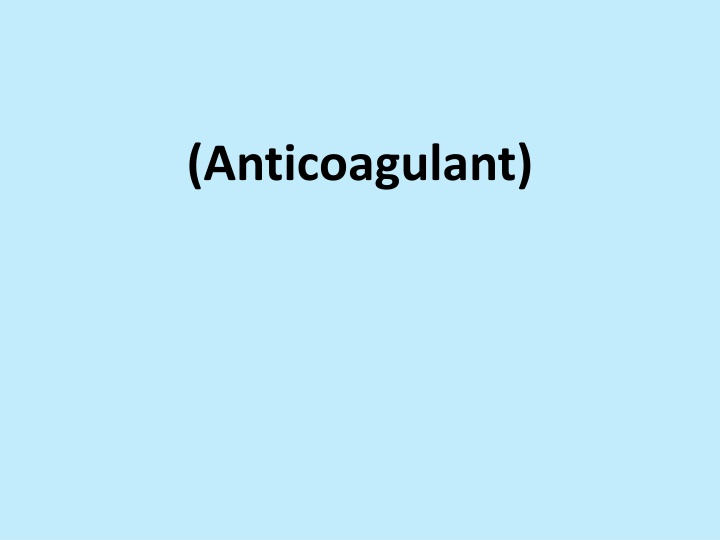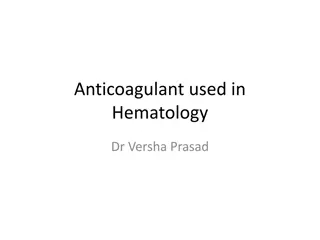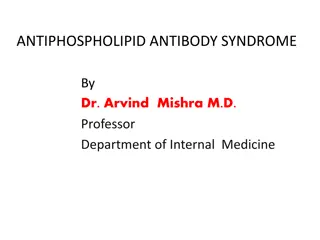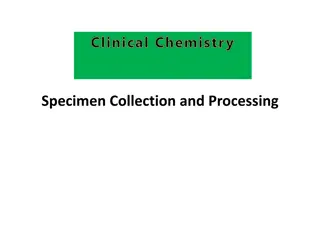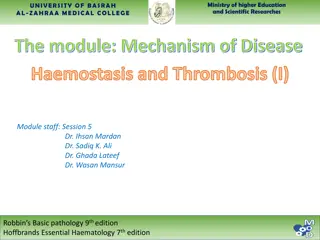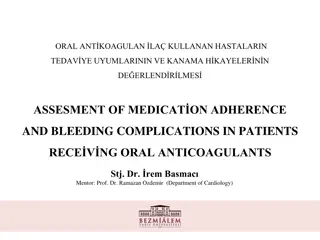(Anticoagulant)
Anticoagulants such as EDTA, Sodium Citrate, and Heparin play crucial roles in preventing blood coagulation by different mechanisms. EDTA and sodium citrate remove calcium, an essential coagulation factor, while heparin inhibits thrombin and other clotting factors. Each anticoagulant has specific uses in hematology and chemistry tests, such as CBC and coagulation studies. Tube selection based on color coding helps in proper collection and processing of blood samples for various tests.
Download Presentation

Please find below an Image/Link to download the presentation.
The content on the website is provided AS IS for your information and personal use only. It may not be sold, licensed, or shared on other websites without obtaining consent from the author.If you encounter any issues during the download, it is possible that the publisher has removed the file from their server.
You are allowed to download the files provided on this website for personal or commercial use, subject to the condition that they are used lawfully. All files are the property of their respective owners.
The content on the website is provided AS IS for your information and personal use only. It may not be sold, licensed, or shared on other websites without obtaining consent from the author.
E N D
Presentation Transcript
(Anticoagulant) Is a substance that prevents blood from coagulation or clotting. The hematology are: 1. EDTA: Ethylen Diamine Tetraacetic acid 2. Sodium citrate 3. Heparine most common anticoagulants used in
EDTA and sodium citrate prevent coagulation by removing calcium which is one of the essential factors in coagulation precipitation. from the blood by Heparin acts by forming compiler with plasma anti- thrombin, which inhibits thrombin and other stages of clotting factor activation.
1) EDTA: Its used in a concentration of 1 to 2 mg/ml of blood It may be used for both hematology and chemistry tests, and anticoagulant for blood cell counts (CBC), ABO Blood grouping. is the preferred
2) Sodium citrate: The ratio is one part of 3.8% aqueous solution to nine parts of whole blood. Its used for blood coagulation and platelet function studies (PT &PTT) and can be used for Erythrocyte sedimentation rate (ESR).
3) Heparin: Its concentration is 0.1 to 0.2 mg/ml of blood. Its good for prevention of hemolysis but it is not satisfactory for leukocyte or platelet counts because of cell clumping. Its also produce a trouble some blue background in wrights stain.
Color code tube selection of anticoagulants commonly used Stopper color Additive Notes Used for blood bank, some chemistries. Red No additive Collection of serum 10-15 min is required to allow blood before centrifugation Collection blood ( binds calcium) to clot Lavender (purple) EDTA of whole
Color code tube selection of anticoagulants commonly used Stopper color Additive Notes Sodium or lithium heparin Inhibits thrombin Green activation. chemistry studies Coagulation studies (bind calcium) (PT &PTT) (ESR). Light blue Sodium citrate
Color code tube selection of anticoagulants commonly used Stopper color Additive Notes Sodium fluoride & potassium oxalate: inhibits enolase (phosphopyrovate dehydrogenase) For glucose determination in chemistry (stabilize glucose in plasma) Gray Sodium iodoacetate: inhibits glocose-3-phosphate dehydrogenase Acid citrate dextrose (ACD) For use in blood bank studies, HLA phenotyping, DNA and paternity testing (preserves red cells) Yellow
Blood collection: Blood sources for hematological tests are venous blood and capillary blood. 1) venous blood: Some tests require a few cubic centimeter of blood. It is obtained from a vein. Vein puncture is usually obtained by drawing specimen of blood from a superficial vein wrist, hand, or ankles.
2) capillary blood: Some tests may be performed with a few drops of blood, the blood is obtained from the lobe of the ear, finger tips or heal surfaces (in case of infants).
Blood Containers Blood must be collected into an FDA-approved container that is pyrogen-free and sterile and contains sufficient anticoagulant for the quantity of blood to be collected. The container label must state the type and amount of anticoagulant and the approximate amount of blood collected. Blood bags may be supplied in packages containing more than one bag. The manufacturer s directions should be followed for the length of time unused bags may be stored in packages that have been opened. 13 by Mohammed Abu-basha
Blood Collection Whole blood is collected in clear plastic bags that contain different mixtures of anticoagulants: 1. Citrate: chelate calcium, preventing coagulation 2. Phosphate: prevents pH from dropping 3. Dextrose: provides nutrients to RBCs during storage 4. Adenine: maintains ATP
Anticoagulants Anticoagulants: CPD Citrate, Phosphate, and Dextrose 21 day shelf life (at 1-6 C) CP2D Citrate, Phosphate, and 2Xdextrose 21 day shelf life (at 1-6 C) CPDA-1 Adenine added 35 day shelf life Additive Solutions prolong red cell survival for 42 days
